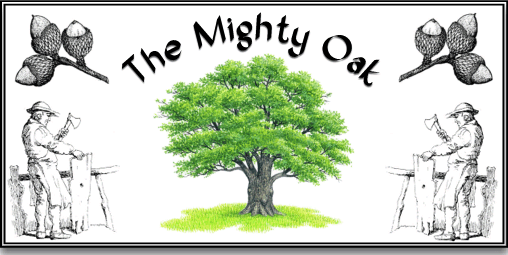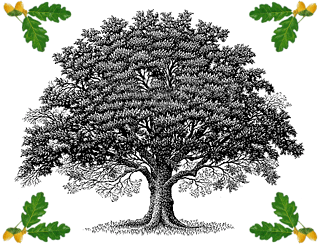
“From little acorns mighty oaks grow”, or as is the case on Dartmoor, “From little acorns oaks of all sizes grow”, from the dwarf oaks of Wistman’s Wood to the ancient ‘Royal Oak of Meavy‘. Normally one could say that many of the native trees do not occur on the high moor but in the case of the oak there are two remaining oak groves at altitudes of over 1,300ft, Black-a-Tor Copse (1,319ft) and Wistman’s Wood (1,350ft). Then as you progress down to the lower moorlands the oak tree becomes common in the woods, hedgerows, and fields. The mighty oak has always been the major source of wood and timber for numerous purposes from buildings to tables and shipbuilding to fencing. Oak wood was a vital source of charcoal which was used as an industrial fuel. The leaves and acorns were an important source of animal browse and fodder. Its bark has been used in numerous processes such as tanning, dyeing, ink making, and pottery glazes. It was such an important tree that at one time it was said that from birth a baby was laid in an oaken cradle and every day after came into daily contact with some form of oak until the last connection with a oaken coffin.
There are place-names that on first impressions refer to the oak tree, but as always this does admirably illustrate the need for caution when looking at place-names. The town of Okehampton, to me, would seem a safe bet for a connection with the oak, but no, it stems from ‘tun’ or homestead by the river Okement. Ok, so perhaps the river Okement is a reference to the oak tree, once again no, its earliest form of 1244 was aqua de Okem (Old Welsh, aku – swift) and m (Old Welsh, myned – to go) thus arriving at the river that ‘swiftly goes’. On the other hand we then have what is now known as the O’ Brook which has derived from Ocbroke which is suggested to mean the ‘Oak Brook’. There are then the usual Oak Hill, Oaken Combe, Oakmoor, and the enigmatic Oak and the Ash which is located near Sandly Hole Pass (OS grid reference SX 622 813) and is said to refer to a site where both trees once stood. Again, this is located at an altitude of nearly 1,500ft which although no problem for an Ash tree is high for an oak.
There are several local dialect words for the oak tree; Chitjack, Cups and Saucers, and Oak-mas and plenty of folklore concerning the tree. In Celtic times the oak tree was worshipped as being the embodiment of the god Teut. In the old Celtic calendar there were 13 months which was measured from one full moon to the next. The oak tree gave its old name of Duir to the period which ran from June to July. Later the oak was regarded as a symbol of Tarnawa who was the god of thunder. The most common and association with the tree was the sacred oak groves of the Druids and this manifests itself at Wistman’s Wood. Here it was thought the ancient rites and rituals of the sacred order were carried out. As the centuries passed much of the woodlands were felled which left individual oak trees standing prominent in the landscape. These individual trees then became an integral part of local tradition and custom. This gave rise to several distinct types of oak trees such as;
Shire Oaks – oak trees which marked the boundaries of shires
Cross Oaks – a stone cross and an oak placed at crossroads, ie Hawson’s Cross
Gospel Oaks – oak trees on the parish boundary where gospels were read during the beating of the bounds.
Bull Oaks – large, hollow trees where livestock could shelter.
Turnpike Oaks – large, hollow oaks beside a road where toll collectors would shelter.
Then, as with the rest of the country was the famous ‘Oak Apple Day’ which took place on the 29th of May, some say this replaced many of the traditional May Day celebrations. The ‘roots’ of this tradition stem back to 1651 when after the battle of Worcester, King Charles II escaped from the Roundheads by hiding in an oak tree. Then when he returned to London in 1660 he introduced Oak Apple Day to celebrate his escape and also to commemorate his birthday. It was local custom that people would wear oak leaves or oak apples to mark the occasion, anyone not conforming to this was open to a good thrashing by children carrying bunches of stinging nettles. Another variation of the custom was to wear oak leaves in the morning and ash leaves in the afternoon. In Tavistock there used to be a mock battle between two sides who represented the Royalists and the Parliamentarians. Water would be their main source of weaponry and normally the fight would take place in the oak leaf decked streets. It was also custom that anyone could cut oak boughs where ever he fancied provided it was before 6.00am. In some areas Oak Apple Day was known as ‘Garland Day’ and this too happened on the 29th of May. The preparation for this day involved young boys going around the countryside plundering as many birds eggs as they could. The only bird safe from this was the robin as it was on pain of death that such a nest be robbed. Once enough eggs had been collected a frame from two crossed hoops would be made and decorated with flowers, the eggs would then be hung from the frame. On Oak Apple morning the garland would be paraded around to the accompaniment of drums and whistles and a collection would be made. In the afternoon the garland would be placed on a post or rock and the boys would compete to see who could smash the most eggs by throwing stones at them. On the northern edges of Dartmoor it was always believed to bring good luck to cut down an oak tree when the moon was waning and the wind coming from the north.
Some carpenters believed that any oak wood should be joined by a wooden peg as opposed to a nail as this ensured that the joint lasted. When beating the parish bounds it is tradition that if an oak tree was incorporated into the ancient bounds then a gospel had to be read at the tree – hence the name ‘Gospel Oak’. Herrick the poet from Dean Prior once wrote:

“Dearest, bury me,
Under that holy oke, or Gospel Tree,
Where, though thou see’st not, thou mayst,
Think upon
Me, when you yearly go’st Procession.
If you ever wanted to be assured of a healthy year then the simple answer was to rub your hands with a piece of oak bark on Midsummer’s Night, this had to be carried out in complete silence.
The oak tree has also been linked to the Norse God Thor who amongst other things was the god of thunder. Accordingly, this gave rise to the tradition of acorn shaped knobs being tied to the bottom of window cords. It was thought any house that sported and in many cases still sport such ornaments would be protected from being struck by a thunder bolt. This belief also applied to the tree which is why occasionally you hear that it’s safe to shelter under an oak tree in a storm – personally I wouldn’t recommend it! There is a suggestion that the association with the oak tree and thunder came about because of the loud creaking and cracking sound the tree emits when being felled. In the 1600’s John Aubrey noted; “When an oak tree is felling, before it falls it gives a kind of shreikes or groanes that may be heard a mile off“.
A well known cure for toothache was to hammer a nail into an oak trunk, at the same time as the last blow hit the nail the toothache would disappear.
For obvious reasons acorns were known as ‘cups and saucers’ and these too had many mystic properties. Young girls would permanently carry one on their persons as it was said to preserve their youthful looks. The acorns also had the ability to predict the length of any relationship. Two acorns would be taken and each one named after the boy and girl, these were then placed together in a bowl of water and if they floated towards each other then the romance would end in a wedding. Conversely, if the acorns drifted apart then the signs were not too good and it was unadvisable to go buying a ring.
The subsequent result of a gall fly is a hard, round gall which is known as an ‘Oak Apple’. If ever a spider was found in a gall it was said to portend a coming illness for the finder, a worm would mean a life of poverty. On the brighter side, warts could be cured by the application of a mixture of crushed oak apple and vinegar.
There are two oak trees on Dartmoor which have been officially classified as ‘Historic Oak Trees’ these are; the Hawson Cross Oak (known as the Stumpy Oak) and the Meavy Oak. Three more are located just outside the National Park boundary and these are the Shilstone Oak, the Ashton Oak and the Honour Oak at Tavistock.
If anybody would like to explore the history of the oak tree then I can thoroughly recommend a book published in 2003 entitled ‘Oak – A British History’. This was written by Harris, Harris and James and published by Windgather Press.
 Legendary Dartmoor The many aspects past and present of Dartmoor
Legendary Dartmoor The many aspects past and present of Dartmoor

2 comments
Pingback: Folklore Tuesday – The musings of The Midnight Messenger
Pingback: So Mossy, So Foggy | Moss and Fog